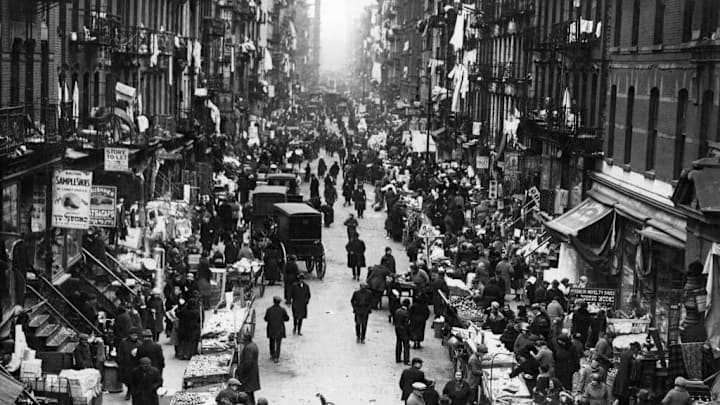On Thanksgiving and Black Friday, bargain hunters will camp outside stores, eagerly waiting for the doors to open—with smartphones and surveillance videos around to capture any bedlam that might ensue.
Surprisingly, frantic crowd behavior isn’t a modern phenomenon; parents who pushed for Tickle-Me Elmo toys in 1996 or Cabbage Patch dolls in 1983 weren’t the first to see anarchy break out in the aisles. For more than a century, shoppers have stampeded towards the most popular holiday gifts they really wanted, but didn’t quite need—and sometimes with tragic results.
- The Victoria Hall Disaster
- Khodynka Tragedy
- Eaton’s Department Store Stampede
- The Nylon Riots
- Hearn’s Department Store Stampede
- Grocery Store Stampede
The Victoria Hall Disaster
In 1883, the organizers of a variety show in northern England promised the children attending the event that they would receive a toy upon exit (the organizers denied reports that the prizes were to go to the first children downstairs). The organizers had intended an orderly exit in which toys were handed out individually, but a surge of 1200 kids rushed to the stairwell, where, at the bottom of the stairs, a door had been propped open inwards about 20 inches and bolted in place.
The bolted door stopped the stampeding children from exiting, and the crowd in the stairwell swelled. Amid all that confusion, children who fell were crushed or suffocated to death, and many others were crushed by the mass of children still entering from the stairwell. Almost 200 children died in the stampede; Queen Victoria’s private secretary wrote that the queen’s “heart bleeds for the suffering of the many bereaved parents.” The New York Times reported days later that the coveted box of toys was still positioned by the door.
Khodynka Tragedy
In 1896, more than 500,000 people crowded onto a Moscow field early in the morning for the coronation of Tsar Nicholas II. The crowd anticipated gifts, including a pretzel and a commemorative cup—but when rumors swirled that not enough gifts were available, panic spread.
Witnesses to what has since become known as the Khodynka tragedy reported a rage in which the stampeding crowd swore, shouted, and pushed toward the sheds where the gifts were held. Attendees who fell were trampled as the angry crowd pressed forward. Almost 1400 people were killed and 1300 were injured, but the celebration didn’t stop after the stampede. Casualties were moved from the site, and the festivities shifted elsewhere on the field. Many attendees were unaware that a tragedy had occurred just hours earlier.
Eaton’s Department Store Stampede
In the 1930s, Eaton’s Department Store in Winnipeg, Canada, held clearance sales every day in January and February. Depression-era shoppers lined up to buy items on steep discount, and smaller store owners also lined up, hoping to resell goods at a markup. The competing consumers were highly aggressive; on one occasion, a man was knocked unconscious during the frenzy. One witness described how a floorwalker, “unperturbed by the sudden appearance of an injured man out cold ... casually commandeered the nearest elevator [and] dragged the injured man by his feet into it.” The sales stampede persisted at the store for decades. In the 1950s, sales staff were known to throw products at crowds to allow shoppers to fight it out among themselves, too.
The Nylon Riots
By August 1945, World War II was almost over, and because nylon was no longer needed for the war effort, production of stockings was able to resume. The government was clear—they weren’t going to involve themselves with the distribution of stockings—and newspapers eagerly anticipated the mad rush women would make to the department stores that received early shipments.
As expected, over the next few months, eager shoppers gathered to snag one of the few available pairs. In New York, 30,000 women flooded a department store. In Pittsburgh, 40,000 women lined up for only 13,000 available pairs. Shoppers tore through the stores looking for the nylon display. Those who scored a pair had to fend off shoppers willing to rip the product from their hands. Some cities saw crowds, others saw chaos. In Augusta, Georgia, women fought physically over the nylons and knocked over display merchandise in their struggles.
The shortage was short-lived. The following March, production increased to 30 million pairs a month, and soon there was plenty for all.
Hearn’s Department Store Stampede
In February 1954, the promise of discounted goods lured thousands of shoppers to the Hearn’s Department Store on 14th Street in New York City. More than 10,000 shoppers crammed the street, demanding the store be opened.
The Washington’s Birthday sale boasted $6.95 television sets and $0.29 cent umbrellas. Watches that were typically $19.95 were $5.22, and pearl necklaces that sold for $39 were $3.
The police intended to only allow 10 shoppers in at a time, but the mob grew impatient, and a flood of people stampeded into the store. In the chaos, dozens of people were injured. A policeman was shoved through a plate-glass door, windows were broken, and customers physically fought each other for goods.
The Washington’s Birthday stampede wasn’t unique to New York in the 1950s. Three years earlier, a price war between competing department stores sent consumers stampeding into stores.
Grocery Store Stampede
An aptly-named “Crazy Day” sale attracted more than 2000 shoppers to a Florida grocery store—which had advertised $75 power lawn mowers for only 99 cents, as well as one-pound packages of coffee for 29 cents—in 1954. The stampeding crowd sent several shoppers to the hospital and frightened store clerks. As the swarm grew, clerks began throwing packages of coffee at the crowd to prevent being attacked, and the police had to be called to restore order.
Discover More Fascinating Stories About Black Friday:
A version of this story was originally published in 2016 and has been updated for 2024.
